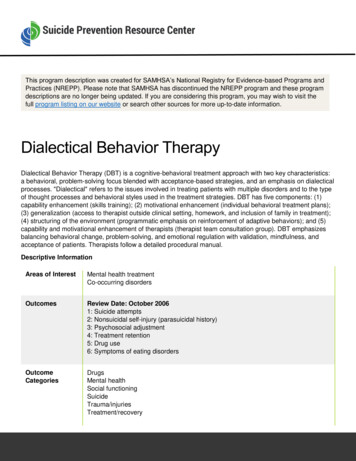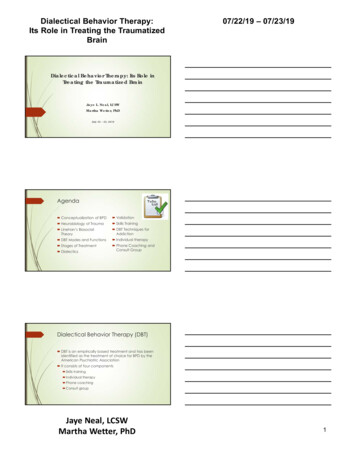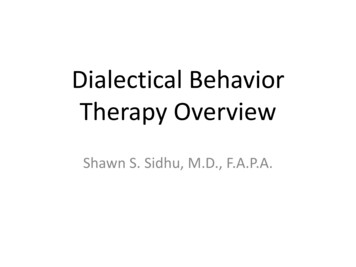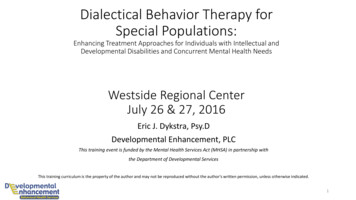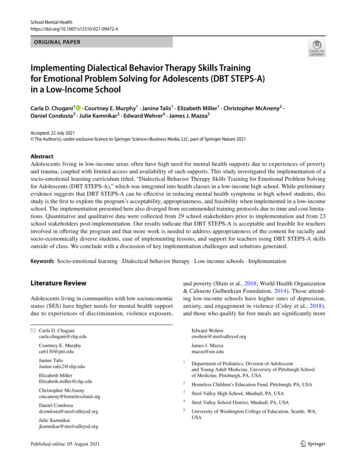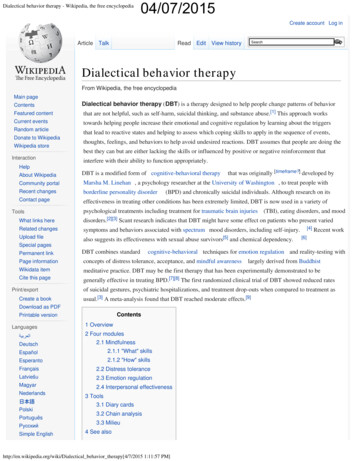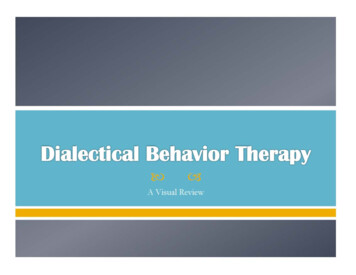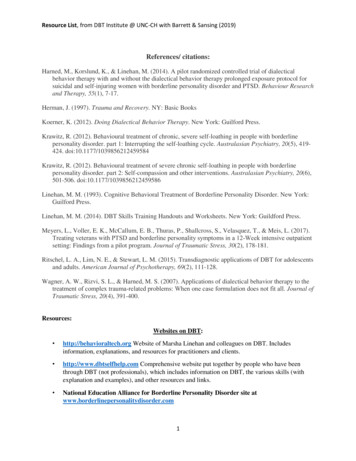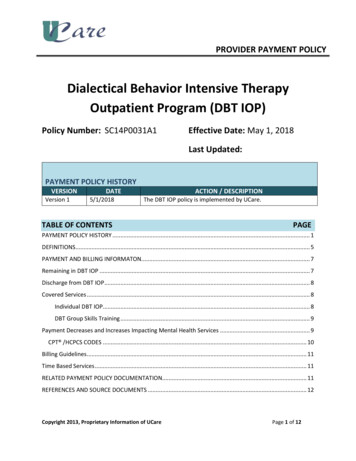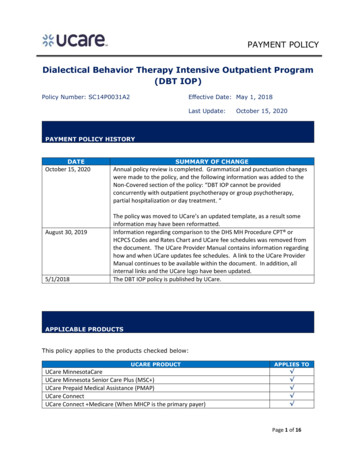
Transcription
Dialectical BehaviorTherapy with AdolescentsMichele Berk, Ph.D.Department of Child and Adolescent PsychiatryStanford University School of MedicineClaudia Avina, Ph.D.Department of Child and Adolescent PsychiatryHarbor-UCLA Medical Center/David Geffen School of Medicine at UCLA
Adolescent Suicide: Overview Suicide is an urgent public health problem among teens. Suicide is the 3rd leading cause of death among 10-14 yearolds (behind accidents and malignant neoplasms) and the2nd leading cause of death among 15-24 year olds (behindaccidents). Prior suicide attempts are one of the strongest predictors ofcompleted suicide and subsequent suicide attempts inyouth (e.g., Lewinsohn et al., 1993). NSSI is also a predictor of subsequent suicide attemptsamong depressed youth (Asarnow et al., 2011; Wilkinson etal., 2011). Adolescent suicide attempters are a high risk population inneed of effective interventions.6/16/2016
% of High School Students in the United States WhoReported “Seriously Considering Attempting Suicide” inthe Past Year(YRBSS; Kann, 17.7
% of High School Students in the United States WhoReported Attempting Suicide in the Past Year(YRBSS; Kann, 611.3African-American10.27.28.9Total11.65.58.6
Definitions Suicide attempt: A potentially self-injuriousbehavior, associated with some evidence ofintent to die Non-suicidal self-injury behavior: Selfinjurious behavior not associated with intentto die (intent may be to relieve distress orcommunicate with another person), oftencalled “self-mutilation,” “suicide gesture.”
Non-suicidal self-injurybehavior No intent to die Risk factor for suicide attempts Not “suicide gestures” Treatment involves determining function ofthe behavior and helping client attainfunction in alternative ways Generally does not require hospitalization Remove means of self-harm
Common reasons forNSSI Affect regulation/avoidance To reduce dissociation Interpersonal communication Self-punishmentKlonsky, 2007.
Relationship between SuicidalBehavior and NSSI NSSI is a predictor of subsequent suicideattempts among depressed youth (Asarnowet al., 2011; Wilkinson et al., 2011). Adolescents often engage in both NSSI andsuicidal behavior concurrently (Whitlock etal., 2012). NSSI increases the risk of engaging in suicidalbehavior and may serve as a “gateway” toattempting suicide (Whitlock et al., 2012).
Risk Factors Past suicide attempt Non-suicidal self-injury Access to weapons/lethal means Psychopathology: Depression, substance abuse, conduct disorder (males) Severe emotion dysregulation The tendency to be aggressive and violent, and to engage in dangerous, illegal, or risky activities Impulsivity Alcohol and drug use/abuse History of child sexual abuse Family conflict Precipitants/triggering events leading to humiliation, shame, or despair (e.g., loss of relationship, conflict withpeers, family members – real or anticipated) Hopelessness, the belief that problems cannot be solved, poor problem solving ability Family history of suicide Severe insomnia and agitation Acute psychosis Bullying LGBT Contagion
Safety Measures Remove lethal means Decreases odds of an impulsivesuicide attempt Safety Planning Parental Monitoring Obtain evidence-based mentalhealth treatment!
What can parents do to help? Reduce family conflict. Increase family support/validation. Increase parent safety monitoring. Take all talk about suicide and self-harm seriously. Listen very closely to what is on your child’s mindand what he/she may be trying to tell you. Validatetheir feelings. Suicidal behavior is a “cry forunderstanding.” You want to convey thisunderstanding BEFORE your child hurts themselves.
Treatment Approaches Despite the severity of the problem, there is littleguidance from the literature on how to best treatsuicidal adolescents. Only 13 randomized, controlled trials (RCTs) oftreatments specifically targeting adolescent suicideattempters with repeat suicide attempts as anoutcome variable. Only 6 studies demonstrated significant decreasesin suicide attempts.
Six Studies Demonstrating Significant Decreasesin Suicide Attempts:1. Multi-systemic therapy was shown to be more effective than hospitalizationat decreasing rates of youth-reported suicide attempts (Huey et al., 2004).2. Developmental group therapy was shown to be more effective than routinecare at decreasing deliberate self-harm (Wood et al., 2001).3. Mentalization-based treatment was shown to be more effective than TAU atdecreasing self-harm (Rossouw & Fonagy, 2012).4. Integrated CBT for co-morbid suicidality and substance abuse was shown tobe more effective than TAU at decreasing suicide attempts (Esposito-Smytherset al., 2011).5. Dialectical Behavior Therapy was shown to be more effective than enhancedusual care at decreasing self-harm behaviors (Mehlum et al., 2014).6. Parent-only psychoeducation: Resourceful Adolescent Parent Program (RAPP) was shown to be more effective than routine care at decreasing self-harmbehaviors (Pineda & Dadds, 2013)
Treatment Research None of these 6 studies have beenreplicated. At present, there are no wellestablished empirically-supportedtreatments for adolescent suicideattempters. Additional research is urgentlyneeded.
DBT is a promising treatment forsuicidal youth: Dialectical Behavior Therapy (DBT) with adults has multiple RCTssupporting its efficacy in decreasing suicide attempts in adults. DBT has been adapted for adolescents (Miller, Rathus, & Linehan, 2007)and small, non-randomized trials of DBT with adolescents have yieldedpromising results. In response to clinical need, DBT is being widely used with adolescents. One RCT of DBT with adolescents has been conducted in Norwaydemonstrating greater reductions in self-harm behaviors than enhancedusual care at 19 week and one year follow-up (Mehlum et al., 2014;2016). Second RCT is currently underway in the United States lookingspecifically at whether or not DBT is effective at decreasing suicideattempts (NCT01528020: Collaborative Adolescent Research onEmotions and Suicide [CARES], PI: Linehan, McCauley, Berk, & Asarnow).
What is DBT? Cognitive-behavioral treatment approach developed by MarshaLinehan, Ph.D. for treating chronically suicidal patients with BorderlinePersonality Disorder. Important DBT references: Linehan, M.M. (1993). Cognitive-behavioral treatment of borderlinepersonality disorder. New York: Guilford Press. Linehan, M.M. (2015). DBT skills training manual. New York:Guilford Press. Linehan, M.M. (2015). DBT skills training handouts and worksheets.New York: Guilford Press. Miller, Rathus, & Linehan (2007). Dialectical behavior therapy withsuicidal adolescents. New York: Guildford Press. For more information about DBT: http://www.behavioraltech.com
DBT - Biosocial TheoryBiological Dysfunction in theEmotion Regulation SystemInvalidating EnvironmentPervasive Emotion Dysregulation
Emotional Vulnerability High Sensitivity Immediate Reactions Low threshold for emotional reaction High reactivity Extreme Reactions High Arousal dysregulates cognitive processing Slow return to baseline Long-lasting reactions Contributes to high sensitivity to next emotionalstimulus
Invalidating EnvironmentInvalidates the valid through pervasivecommunication that responses of theindividual are incorrect, faultyinappropriate or otherwise invalid andoversimplifies changing invalid responses byfailing to respond to the individual’s needs.
Effects of the InvalidatingEnvironment Individuals do not learn to accurately labelemotions Individuals do not learn how to toleratedistress Individuals learn to self-invalidate Individuals learn that only escalatedexpressions of negative affect are takenseriously
Summary of DBT Theory Individuals who are biologically predisposed toexperiencing very strong emotions AND experienced invalidation of their emotions bycaregivers Experience very strong negative emotions but knowfew skills to manage them. Suicidal/self-injurious behavior is used as amaladaptive means of coping with negativeemotions. DBT teaches positive coping skills.
Overview of DBT Treatment
Standard DBT Components Outpatient Individual Psychotherapy Outpatient Multi-family Group Skills Training Therapists’ Consultation Meeting (DBT Team) 24/7 Telephone Coaching
Overarching DBT Goal“Building A Life Worth Living”
Mindfulness Meditation practice Attention training Awareness of the present momentwithout judgment Awareness of thought processes leadsto greater control over behavior Acceptance
Validation Letting the client know behaviors“make sense” and that the therapistunderstands his/her thoughts,feelings, or behaviors. Linehan added validation to DBT inorder to facilitate change.
Dialectics “the synthesis of opposing forces” Opposite emotions, “truths,” and ideas can co-exist Targets extreme, erratic behaviors seen in BPD “black and white” thinking “splitting” With adolescents, targets parent/teen conflict Key dialectic: “validation and change.”
DBT Skills Modules Mindfulness Distress Tolerance Distraction Self-soothing Middle Path (Adolescent DBT Only) Emotion Regulation Interpersonal Effectiveness
DBT in a Community Setting Adolescent DBT Program started at Harbor-UCLAMedical Center in March, 2006 Program is housed within the larger Los AngelesCounty Department of Mental Health clinic, whichis connected to a county hospital. Treats approximately 20 adolescents per year. Majority of adolescents treated are underserved,disadvantaged, ethnic minorities (primarilyLatino). Services are provided in both English and Spanish.
Development of the Harbor-UCLAProgram Dr. Berk only staff member trained in DBT Adolescent DBT book and manual were not published when westarted our program, leaving a lot of unanswered questions. Needed to educate staff about DBT is and evidence-based treatments Needed to determine inclusion/exclusion criteria, treatment length Team included both permanent staff and trainees Adopt or adapt? Empirical support is for full DBT program only Over time we were able to “adopt” full program. Staff reactions: “why are you better able to treat these patients thanus?” Other staff reactions: wanted to refer every severe client to DBTprogram, regardless of fit. What about patients who don’t commit?6/16/2016
Working with Latino Families Language Issues Individual Therapy Availability of Spanish speaking providers Translational issues between child and parent Multi-Family Group Cultural Issues Peeling the layers of an onionDon’t ask, don’t tellI’m not BuddhistFamily roles
Special Issues Related to EngagingCommunity Youth and Families inTreatment Improving Access to Mental Healthcare Transportation, Geography, Case Management Caregiver involvement DBT has specific therapeutic strategies geared at keepingclients committed to treatment Navigating systems of care
Typical Teen and Family Reactionsabout DBT Teens state that DBT was helpful despiteresisting the skills group during treatment Family members recognize the benefits tothemselves in addition to their teen Over time, family members support DBT’streatment hierarchy of prioritizing safetyover other issues
Who needs DBT? DBT originally evaluated with suicidal and severelyemotionally dysregulated adult clients There is promising empirical support that DBT iseffective with emotionally dysregulatedadolescents A comprehensive DBT program is an intensive andstructured treatment package Other evidence-based practices may be effective intreating suicidal adolescents
Tips for Finding DBT in YourCommunity Look on behavioraltech.org for trained DBTproviders If needed, encourage providers in your area to gettrained in DBT Ask about prior training in DBT Ask about experience in treating suicidaladolescents Consider comprehensive DBT programs Be prepared to invest time and effort in the DBTprogram
Dialectical Behavior Therapy (DBT) with adults has multiple RCTs supporting its efficacy in decreasing suicide attempts in adults. DBT has been adapted for adolescents (Miller, Rathus, &
